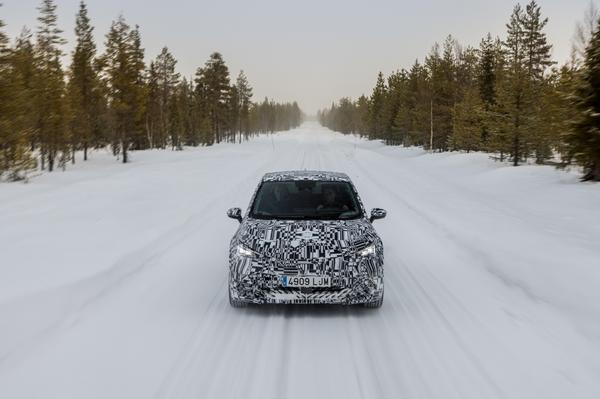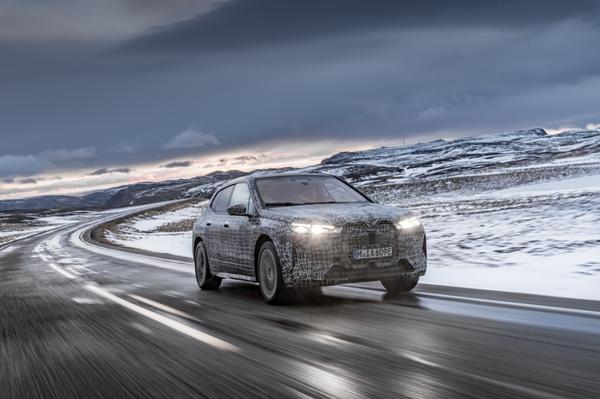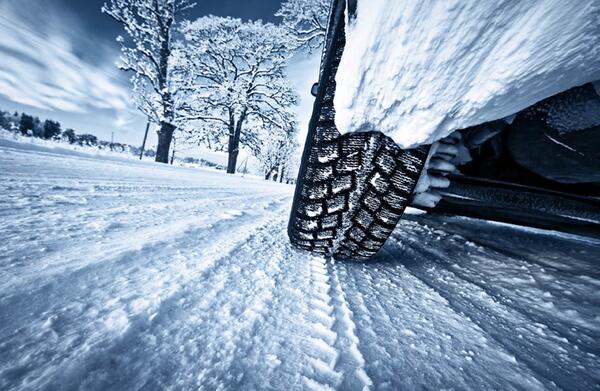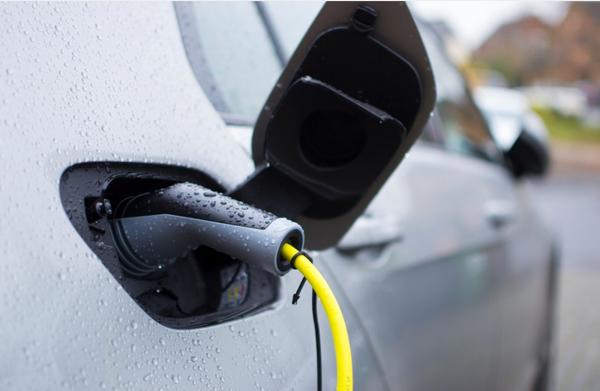Advice
Electric cars in winter: cold weather range and driving tips
How will an electric car cope in snow, on ice, or driving through flooded patches?


Words by: Andrew Woodhouse
Last updated on 13 December 2023 | 0 min read
Are you wondering how winter weather will affect your electric car? Here we cover everything you need to know – from shortened battery range to driving through floodwater – so you can tackle the winter months with confidence.
Jump to: • Battery life in bad weather • Driving in bad weather • Towing in bad weather • Winter tyres for electric cars • Charging and maintaining your car
Jump to: • Battery life in bad weather • Driving in bad weather • Towing in bad weather • Winter tyres for electric cars • Charging and maintaining your car
Electric car batteries in cold weather
Expect to get fewer miles out of your electric car battery in cold weather. The number of miles you’ll get between charges can drop by anything from 10 per cent to 20 per cent depending on the model – so you’ll have to factor in more stops at electric charging points over the winter months.
Why does cold weather affect electric batteries?
Electric cars use lithium-ion batteries, which generate electricity when the lithium ions move from the anode to the cathode in the battery. When it’s cold, this movement slows down, and so electricity production and battery performance are reduced.
But don’t worry too much, as there are a few things you can do to compensate.
But don’t worry too much, as there are a few things you can do to compensate.
Getting more miles out of your electric car battery in winter
Drive in an efficient way
Avoiding sudden acceleration and braking, driving at a steady speed, and driving a little more slowly generally will help get the most miles out of your battery. Only use the air conditioning when necessary too, especially during the early stages of your journey when it’ll have to work harder to get to temperature.
Use eco mode
Many electric cars have an “eco mode”, which focuses battery power where it’s needed and away from features like the heaters, speakers, and gadgets. If your battery is dropping a bit too fast for your liking, whack eco mode on and head to your nearest charging point.
Cover your electric car
Keep your electric car in a garage or enclosed parking space, or even just under a cover, as this can help keep the car and its battery warmer. The warmer it is, the more likely it is to hold its charge.
Preheat the car and battery
Most modern electric cars have a feature called ‘preconditioning’, which allows you to set the car to warm up while it’s still plugged in. That way, you’re not using the car’s battery to heat the car. Depending on the car, you may be able to do this remotely via a phone app, or on a timer so it’s ready to go before you leave for work.
Use regenerative braking wisely
Electric and plug-in hybrid cars use regenerative braking. This means that when you slow or brake, the electric motor acts as a generator and sends the energy back to the battery to top you up. It’s a way of recharging a little bit as you drive. Usually you can adjust the strength of the system from a “one-pedal driving” mode that slows the car aggressively so you’ll rarely need to use the brake pedal, through to a much weaker effect – or off completely.
It’s generally best to use the strongest setting you’re comfortable with during lower speed or city driving, where the stop-start traffic will keep adding a little charge to your battery. But on a clear motorway, it’s often wise to turn it off so you can maintain speed by coasting.
It’s generally best to use the strongest setting you’re comfortable with during lower speed or city driving, where the stop-start traffic will keep adding a little charge to your battery. But on a clear motorway, it’s often wise to turn it off so you can maintain speed by coasting.

How to drive your electric car in winter
As with any vehicle, sensible driving (and driving only when necessary) is key to keeping yourself and your vehicle safe in bad weather.
Whether it’s ice, snow, or heavy rain, you should weigh up whether it’s worth making a journey and make sure you follow the Highway Code when driving.
Whether it’s ice, snow, or heavy rain, you should weigh up whether it’s worth making a journey and make sure you follow the Highway Code when driving.
Driving an electric car in snow
Electric cars are built in a way that means they may actually cope better on snowy roads than petrol or diesel cars do.
In most electric cars, the heavy battery is located underneath the seats, between the front and rear axles, which gives the car a low centre of gravity. This effectively ‘presses the car into the ground’, which can help with traction on a snowy road. Electric cars also include features like stability control and anti-lock braking, which can further support handling and traction by monitoring your speed, reducing wheelspin and activating the brakes for you. Some may also have a specific ‘winter’ mode to help in slippery conditions. Just remember that every car is different, and it ultimately depends on your driving style, so make sure you’re driving safely.
In most electric cars, the heavy battery is located underneath the seats, between the front and rear axles, which gives the car a low centre of gravity. This effectively ‘presses the car into the ground’, which can help with traction on a snowy road. Electric cars also include features like stability control and anti-lock braking, which can further support handling and traction by monitoring your speed, reducing wheelspin and activating the brakes for you. Some may also have a specific ‘winter’ mode to help in slippery conditions. Just remember that every car is different, and it ultimately depends on your driving style, so make sure you’re driving safely.
Driving an electric car on ice
Electric cars are generally heavier than petrol or diesel cars, so it’s even more important to drive slowly and carefully in icy conditions, as any slides may be harder to bring back under control. Read our tips for driving on ice and in other winter conditions here.
Driving an electric car through floodwater
Try to avoid driving through floodwater where possible, as it can cause serious damage to any car – petrol, diesel or electric.
If you have to drive through heavy water, make sure you follow all the usual advice and do not put yourself, other road users, or your car at risk. Electric cars do have several safeguards that mean you can, if absolutely necessary, drive through a flooded area. The drive units and batteries in electric cars are sealed, so they’re unlikely to be damaged by splashes of water. Electric cars don’t have an air intake or an exhaust, so the propulsion system shouldn’t be affected if you drive through water. But water can still enter the vehicle and damage the cabin and components. It could even reach the car’s electronic control units (ECUs), which control various functions in the car. If the wheels are submerged in water, the brakes might not work properly either, so just avoid the risk as much as you can. The higher the water level and the longer you drive through a submerged road, the higher the risk of damage is – so drive steadily and minimise your contact with water where possible. Generally, the bottom of a standard family car’s doors are slightly higher than the kerb. So, if the kerb isn’t fully submerged and you drive slowly and steadily, you might get through without water entering the cabin. Learn more about driving in rain and floods, and how to avoid aquaplaning.
If you have to drive through heavy water, make sure you follow all the usual advice and do not put yourself, other road users, or your car at risk. Electric cars do have several safeguards that mean you can, if absolutely necessary, drive through a flooded area. The drive units and batteries in electric cars are sealed, so they’re unlikely to be damaged by splashes of water. Electric cars don’t have an air intake or an exhaust, so the propulsion system shouldn’t be affected if you drive through water. But water can still enter the vehicle and damage the cabin and components. It could even reach the car’s electronic control units (ECUs), which control various functions in the car. If the wheels are submerged in water, the brakes might not work properly either, so just avoid the risk as much as you can. The higher the water level and the longer you drive through a submerged road, the higher the risk of damage is – so drive steadily and minimise your contact with water where possible. Generally, the bottom of a standard family car’s doors are slightly higher than the kerb. So, if the kerb isn’t fully submerged and you drive slowly and steadily, you might get through without water entering the cabin. Learn more about driving in rain and floods, and how to avoid aquaplaning.

Getting winter tyres for your electric car
Winter tyres are available for electric cars and are definitely worth considering. They make a massive difference when driving on snowy or rainy roads.
Winter tyres are made of a special compound designed to stay softer in cold temperatures. That alone improves grip, but in addition their tread pattern is unique, including additional grooves to help dig into snow and ice, and dispel water more effectively. Electric cars tend to weigh more than similarly sized petrol or diesel cars, and have lots of torque, so their tyres are optimised to deal with these characteristics. Some EVs have quite unusual tyre sizes too. So, you’ll need to make sure your winter tyres are suitable for your electric car. Check the handbook or with the manufacturer for guidance on which specific tyres are suitable for your make and model. Learn more about winter tyres here. When it comes to choosing winter tyres for your electric car, keep the following in mind: • Winter tyres with a lower rolling resistance can give you a better range, because turning the wheel requires less energy. • Low noise tyres will help maintain the peace and quiet of an electric car’s cabin. If you don’t opt for winter tyres, at very least keep an eye on your tyre pressure and tyre tread to make sure you’re getting as much grip as possible.
Winter tyres are made of a special compound designed to stay softer in cold temperatures. That alone improves grip, but in addition their tread pattern is unique, including additional grooves to help dig into snow and ice, and dispel water more effectively. Electric cars tend to weigh more than similarly sized petrol or diesel cars, and have lots of torque, so their tyres are optimised to deal with these characteristics. Some EVs have quite unusual tyre sizes too. So, you’ll need to make sure your winter tyres are suitable for your electric car. Check the handbook or with the manufacturer for guidance on which specific tyres are suitable for your make and model. Learn more about winter tyres here. When it comes to choosing winter tyres for your electric car, keep the following in mind: • Winter tyres with a lower rolling resistance can give you a better range, because turning the wheel requires less energy. • Low noise tyres will help maintain the peace and quiet of an electric car’s cabin. If you don’t opt for winter tyres, at very least keep an eye on your tyre pressure and tyre tread to make sure you’re getting as much grip as possible.
Can I tow another vehicle using an electric car?
It’s still a common courtesy to tow another vehicle through snowy drifts, but will that be possible when we’re all driving electric cars?
Some electric cars available today can tow another vehicle, but most probably shouldn’t. Check with the manufacturer, handbook, or dealership as to whether your specific make model can tow another vehicle. As for why they shouldn’t, electric cars tend to weigh more than comparable petrol or diesel cars, so once you start adding extra weight by towing another vehicle, you’re at risk of over-stressing components like the brakes and transmission. If your electric vehicle uses a regenerative braking system, which is tuned to the car’s original kerb weight, then you risk throwing it out by towing another vehicle. You can turn regenerative braking off, but towing will still put extra strain on the friction braking system. Some electric models are capable of towing, including the Tesla Model X, Audi E-Tron, Mercedes EQC, Polestar 2 and Citroën eSpaceTourer. The weight they can tow varies, so check before you buy if you have a caravan or similar in mind. While older electric cars will struggle with towing, technology is moving in the right direction so, eventually, most electric cars should be able to tow. You just need to do your research.
Some electric cars available today can tow another vehicle, but most probably shouldn’t. Check with the manufacturer, handbook, or dealership as to whether your specific make model can tow another vehicle. As for why they shouldn’t, electric cars tend to weigh more than comparable petrol or diesel cars, so once you start adding extra weight by towing another vehicle, you’re at risk of over-stressing components like the brakes and transmission. If your electric vehicle uses a regenerative braking system, which is tuned to the car’s original kerb weight, then you risk throwing it out by towing another vehicle. You can turn regenerative braking off, but towing will still put extra strain on the friction braking system. Some electric models are capable of towing, including the Tesla Model X, Audi E-Tron, Mercedes EQC, Polestar 2 and Citroën eSpaceTourer. The weight they can tow varies, so check before you buy if you have a caravan or similar in mind. While older electric cars will struggle with towing, technology is moving in the right direction so, eventually, most electric cars should be able to tow. You just need to do your research.
Can an electric car be towed?
This also depends on the make and model, but as a general rule electric cars shouldn’t be towed.
Most electric cars lack a neutral transmission position, so the motor(s) are permanently engaged. If someone pulls you along with a tow rope and all your wheels are on the road, you risk damaging the drivetrain and control units. A lot of electric cars also have automatic parking brakes that engage when the engine is switched off, so you could damage those in being towed. There are some workarounds, though: a two-wheel drive EV could potentially be moved using a towing dolly to lift the driven wheels off the ground, for example. But you should do your research, as the damage can be costly if you get it wrong. Ideally, you should call a breakdown recovery service and avoid asking someone to tow your electric car.
Most electric cars lack a neutral transmission position, so the motor(s) are permanently engaged. If someone pulls you along with a tow rope and all your wheels are on the road, you risk damaging the drivetrain and control units. A lot of electric cars also have automatic parking brakes that engage when the engine is switched off, so you could damage those in being towed. There are some workarounds, though: a two-wheel drive EV could potentially be moved using a towing dolly to lift the driven wheels off the ground, for example. But you should do your research, as the damage can be costly if you get it wrong. Ideally, you should call a breakdown recovery service and avoid asking someone to tow your electric car.

Charging will take more time in cold weather
Because lithium-ion batteries are affected by the cold, you should expect overnight charging to take an extra couple of hours in cold weather. Similarly, rapid charging could take up to 45 minutes rather than the usual 30.
Charging points can be affected by cold weather. Tesla, for instance, has stated that extreme cold weather can result in slower charging speeds at its dedicated Supercharger stations. Prepare for queues and longer waits at charging stations. Make sure you’re getting to a charging station with enough charge left to last (do not leave it to the last minute) and set off a bit earlier to factor those wait times in. Find electric car charging points near you.
Charging points can be affected by cold weather. Tesla, for instance, has stated that extreme cold weather can result in slower charging speeds at its dedicated Supercharger stations. Prepare for queues and longer waits at charging stations. Make sure you’re getting to a charging station with enough charge left to last (do not leave it to the last minute) and set off a bit earlier to factor those wait times in. Find electric car charging points near you.
Charging an electric vehicle in rain or snow
Electric cars are designed and built to withstand rain and water intrusion, and both electric cars and charging stations use protective layers and covering shields that prevent water mixing, short circuiting, sparks or loss of current, meaning it’s safe to charge an electric car in rain.
Can I charge an electric car in a power cut?
Surprisingly, you might be able to charge your electric car in a power cut.
Some charging stations have battery backup systems, so they’ll still have power you can access even if the grid is down. Obviously, the available power is going to be limited so we’d discourage you from relying on it. It certainly doesn’t make sense to set off in search of a charging point in a power cut, but if you’re already out and in desperate need of a top-up, don’t despair before you try a charging point.
Some charging stations have battery backup systems, so they’ll still have power you can access even if the grid is down. Obviously, the available power is going to be limited so we’d discourage you from relying on it. It certainly doesn’t make sense to set off in search of a charging point in a power cut, but if you’re already out and in desperate need of a top-up, don’t despair before you try a charging point.
Can I charge an electric car in a power cut?
Surprisingly, you might be able to charge your electric car in a power cut.
Some charging stations have battery backup systems, so they’ll still have power you can access even if the grid is down. Obviously, the available power is going to be limited so we’d discourage you from relying on it. It certainly doesn’t make sense to set off in search of a charging point in a power cut, but if you’re already out and in desperate need of a top-up, don’t despair before you try a charging point.
Some charging stations have battery backup systems, so they’ll still have power you can access even if the grid is down. Obviously, the available power is going to be limited so we’d discourage you from relying on it. It certainly doesn’t make sense to set off in search of a charging point in a power cut, but if you’re already out and in desperate need of a top-up, don’t despair before you try a charging point.
Ready to make the switch?
More and more drivers are ready to switch to electric and, luckily, there’s a greater choice of electric cars available than ever before.
Start your search with: • The best electric cars available today • The best EV finance deals • Electric cars available and in stock today Don't forget to enter our monthly giveaway for your chance to win a brand-new electric car!
Start your search with: • The best electric cars available today • The best EV finance deals • Electric cars available and in stock today Don't forget to enter our monthly giveaway for your chance to win a brand-new electric car!